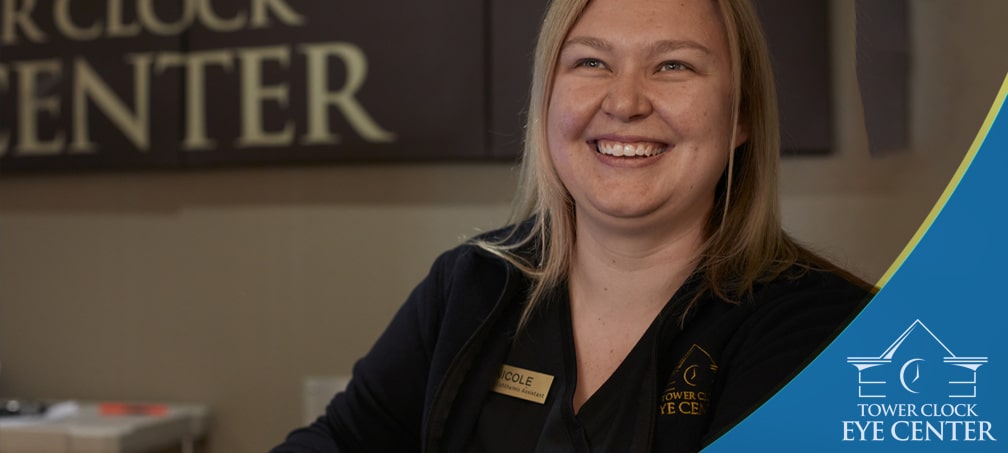
Diabetic Retinopathy
Are you experiencing blurry vision or changes to your vision that concern you? If you have diabetes, these symptoms could be a sign of diabetic retinopathy. This serious eye disease requires immediate medical attention.
At Tower Clock Eye Center, we specialize in diagnosing and treating this condition so we can help protect your vision and maintain your overall eye health. If you have diabetes or are noticing changes in your vision, it’s important to schedule an eye exam to check for potential issues so you can find the best course of treatment.
What Is Diabetic Retinopathy?

As the blood vessels continue to weaken, abnormal new blood vessels may grow in the eye. These new vessels are fragile and prone to leaking fluid into the retina, which can cause swelling and further complications.
According to the American Diabetes Association, people with diabetes are at a higher risk of developing diabetic retinopathy, making it all the more important to understand how the disease progresses and to seek regular eye care.
In the early stages diabetic retinopathy may not cause noticeable symptoms, so regular eye exams are essential for early detection. The earlier the condition is detected, the better the chance of preventing significant vision loss. Early detection can make a big difference in minimizing vision damage.
Causes of Diabetic Retinopathy

Initial Damage: High blood sugar weakens the walls of blood vessels, causing them to develop tiny bulges that leak blood and fluid into the retina.
Inflammatory Response: The body tries to heal the damaged blood vessels, which can lead to scar tissue and damage to the retinal tissue.
Vessel Closure: Some blood vessels may become blocked, cutting off the oxygen and nutrients needed for the retina to function.
New Vessel Growth: The eye attempts to grow new blood vessels to compensate for the blocked ones, but these vessels are often weak and can leak fluid.
Several other factors can contribute to high blood sugar levels, including:
- Poor diabetes management
- Irregular monitoring of blood glucose levels
- Inconsistent medication use
- Lack of regular exercise
- Poor dietary choices
Those Most at Risk for Developing Diabetic Retinopathy

Medical research has shown that keeping blood sugar under control can reduce the risk of developing diabetic retinopathy or slow its progression. Regular check-ups and following your prescribed treatment plan are key to protecting your vision.
According to the National Eye Institute, key risk factors include:
- Duration of diabetes (longer duration increases risk)
- Pregnancy (gestational diabetes)
- Smoking
- Obesity
- African American, Hispanic or Native American heritage
Two Stages of the Disease
Diabetic retinopathy typically progresses through two stages, each with distinct characteristics and potential complications. Understanding these stages is essential for both patients and healthcare providers, as early detection and timely treatment at each stage can significantly improve outcomes.
Regular monitoring by a specialist who has experience with diabetic retinopathy can help track the disease’s progression from early to advanced stages, ensuring intervention when necessary.
Non-Proliferative Diabetic Retinopathy
In the early stage of diabetic retinopathy, known as non-proliferative diabetic retinopathy (NPDR), blood vessels in the retina begin to weaken and leak fluid, leading to swelling of the retina. This stage is often asymptomatic, but it can eventually lead to diabetic macular edema (DME), which affects central vision and is one of the leading causes of vision loss in people with diabetes.
During this stage, you might experience:
- Blurred vision
- Cloudy vision
- Changes in how you see colors
- Floating spots in your vision
Proliferative Diabetic Retinopathy
As the disease progresses, it reaches the proliferative stage. This advanced stage is characterized by the growth of abnormal new blood vessels on the retina’s surface. These new vessels are fragile and prone to leaking, which can lead to more severe complications, including retinal detachment and permanent vision loss.
The key features of proliferative diabetic retinopathy include:
- Growth of abnormal blood vessels
- Formation of scar tissue
- Potential retinal detachment
- Risk of significant vision impairment
At Tower Clock Eye Center, our experienced eye doctors are committed to monitoring your condition closely, helping to manage diabetic retinopathy and prevent its progression. We’re here to guide you through each stage, providing the care and treatment needed to preserve your vision.
Possible Complications Resulting From Diabetic Retinopathy

- Diabetic Macular Edema (DME): Fluid leakage from damaged blood vessels can cause the macula (the part of the retina responsible for central vision) to swell, leading to blurred vision and difficulty seeing fine details.
- Retinal Detachment: Scar tissue from abnormal blood vessels can pull the retina away from the back of the eye, causing vision loss.
- Glaucoma: Abnormal blood vessels can block the eye’s normal fluid drainage system, leading to increased pressure and damage to the optic nerve.
- Permanent Vision Loss: If this condition progresses without treatment, it can lead to permanent blindness.
Treatment Options
Early intervention is crucial in managing diabetic retinopathy, as it can significantly impact the health of your vision. At Tower Clock Eye Center, your eye doctor will carefully assess the extent of any damage to your retina and optic nerve, ensuring that we understand your unique condition. From there, we will develop a personalized treatment plan tailored to your needs, helping to slow the progression of the disease and protect your vision for the future.
Laser Treatment
Laser treatments are one of the most effective ways treatments and prevent further damage. Your doctor may use modern laser techniques to seal leaking blood vessels and reduce the growth of new, abnormal vessels. There are different types of laser treatments:
- Focal Laser Treatment: Targets specific leaking blood vessels.
- Scatter Laser Treatment: Treats larger areas of the retina to prevent new blood vessel growth.
- Pattern Laser Treatment: Uses computer-guided lasers to treat multiple areas at once.
Laser treatments have proven safe and highly effective, particularly when diabetic retinopathy is detected early.
Prevention and Management Strategies

- Regular Blood Sugar Monitoring: Keep track of your blood glucose levels and maintain them within a healthy range, as advised by your doctor.
- Healthy Diet: Eat a balanced diet that helps keep blood sugar levels stable.
- Regular Eye Exams: Schedule an annual dilated eye exam, or more frequently if recommended by your eye doctor.
By understanding the risks of diabetic retinopathy and actively managing your diabetes, you can take important steps to protect your vision. Regular eye exams are key to catching any changes early, allowing us to treat diabetic retinopathy before it causes severe damage and helping you maintain clear, healthy vision for years to come.
Contact Tower Clock Eye Center for a Diabetic Retinopathy Diagnosis
If you have diabetes or are noticing changes in your vision, don’t wait for symptoms to worsen before seeking help. Early detection and treatment are key to preventing vision loss. At Tower Clock Eye Center, we offer comprehensive care for patients with diabetic eye disease.
We recommend scheduling a comprehensive dilated eye exam at least once a year if you have diabetes. Since diabetic retinopathy can develop without noticeable symptoms, regular screenings are crucial for catching the condition early.
Let Us Help Your Vision
To schedule your eye exam or learn more about how we can help manage your diabetic retinopathy, contact Tower Clock Eye Center today. Our dedicated team of eye doctors is here to protect your vision and provide the best care possible for your eyes.
Call us at (920) 499-3102 to schedule your eye exam today.
